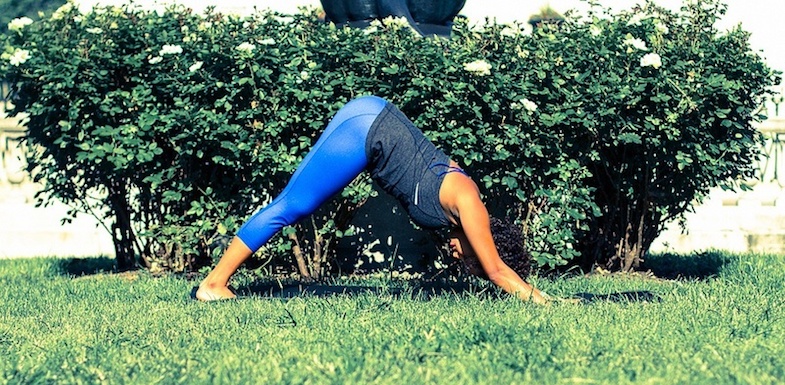Lower back pain is one of the nation’s most common health concerns. It accounts for 40% of all missed time from work. The good news is that 90% of patients will improve on their own without a doctor’s help. The best exercises for lower back pain can help you strengthen your muscles, while reducing the tension causing pain in the first place. In this list, we’ve pulled together six lower back pain exercises that aren’t commonly talked about when it comes to back pain prevention. All of these exercises are low-impact so they can be used by a variety of pain patients. If you haven’t tried these already, we encourage you to grab a friend and try them now!
Why is finding the best exercises for lower back pain so important?
“For most people, back pain is not a disease,” says Dr. Mike Evans, a health care educator. That means it is possible to live without back pain.
The bad news is that many cases of back pain recur. About 30% of people with back pain will experience a recurrence within six months, and 40% within one year, according to Evans. The high rate of people who experience recurring or chronic back pain underscores the importance of treating the condition’s root cause.
Just because it’s possible to live without lower back pain doesn’t mean it’s effortless. Taking the right steps makes all the difference. One of those steps is finding the best exercises for lower back pain that work well for you.
The high rate of recurrence is because back pain is commonly caused by lifestyle factors that, when left unchanged, continue to create conditions ripe for pain. Fortunately, the lifestyle factors that lead to back pain are relatively easy to change. It just takes a dose of willpower and perseverance coupled with a positive mindset.
Why low impact exercises?
Low impact exercises are some of the best exercises for lower back pain. Low impact aerobic exercise involves activities that put less pressure on the joints but still gets the heart moving. Instead of jarring the spinal structure and other joints with pounding activities like running, low impact activities get the blood moving and nutrients flowing through important structures of the back, supporting healing without pressure on sensitive bones and joints. Additional benefits include weight loss which takes the pressure off joints, less stiffness with regular movement, and increased production of endorphins, the “feel good” hormones the body produces after 30-40 minutes of exercise.
The most commonly recommended low impact exercises for lower back pain include walking and swimming. These are, seriously, two of the best exercises for lower back pain that you can do. However, you may be burnt out on walking and not have access to a pool. Or, you like trying something new when you’re getting your blood pumping. That’s why we recommend some new options for lower back pain exercises later in this post.
What are common lower back pain causes?
Before we look at six of the best exercises for lower back pain, let’s take a look at what actually causes lower back pain.
Lower back pain is often caused by skeletal misalignment. The most common cause of back pain is mechanical—a misalignment or malfunctioning somewhere within the intricate network of bones, joints, and ligaments that make up the spine. The exact cause is often difficult to pinpoint. In fact, only about 15% of patients with back pain end up learning the exact reason underlying the pain, according to a report in the Journal of General Internal Medicine.
Looking a little bit more deeply, this misalignment typically doesn’t happen on its own. One of the top risk factors is a sedentary lifestyle, one spent mostly seated and with little physical activity. A sedentary lifestyle promotes poor posture and increases the likelihood of weight gain, both risk factors for lower back pain. Spending a great deal of time sitting also weakens back muscles, many of them important for supporting the spine and creating proper postural alignment. Poor posture mixed with weak muscles is an effective recipe for back pain.
You can learn more about the science of back pain in the following video.
The research on lower back pain exercises
Study after study has shown that physical activity is one of the best things a person can do to reduce back pain. The best exercises for lower back pain, as we’ll see, combine movement and activity with a sense of fun that keeps people coming back.
For example, a study published in the journal Clinical Rehabilitation found that patients with chronic lower back pain who walked on a treadmill twice each week experienced similar pain reduction to patients who sought more intensive medical treatment, reports the Huffington Post. Other good long-term options for reducing the risk of back pain recurrence include strength-building activities. Prevention is often the best medicine and will allow patients greater life enjoyment over the long term.
For many patients, realizing that it’s healthy to move around with back pain requires shifting their mindset.
Over the past few decades, doctors have recommended movement to alleviate lower back pain, but this wasn’t always the case. Until the 1990s, doctors recommended bed rest. Because of this, many back pain patients are scared to exercise, worried that they’ll aggravate the pain when in reality, physical activity is perhaps the No. 1 way to feel better.
Now we know how important exercise really is for reducing and preventing lower back pain. Let’s take a look at six of the best exercises for lower back pain that you probably haven’t tried yet.
1. Slow down with tai chi
Tai chi is an ancient Chinese martial art that combines slow, fluid movement, breathing, and meditation. Descended from the combative martial art Tai Chi Quan, tai chi focuses on alignment, balance, stamina, and control rather than combat. Because of this, tai chi has many health benefits, one of which is the alleviation of lower back pain. This focus on steady, sustained movements makes it one of the best exercises for lower back pain. And, since it’s so low-impact, patients who also have knee or hip pain can also practice it easily.
The exercises in tai chi flow from one to another fluidly. The speed can vary based on experience and ability, so the focus can be on proper form, not building cardiovascular strength or completing a certain number of repetitions. For people with lower back pain, this slow movement helps them increase their range of motion without moving too quickly or abruptly. It also helps to strengthen the muscles surrounding the spine to offer more support.
The benefits of tai chi
Beginners to tai chi will spend quite a bit of time learning the sequence of movements, and doing so helps to improve strength by increments. The physical demands of tai chi are not intense or immediate. Instead, movements are learned individually and then gradually put together. Because tai chi is so low impact, people of all ages can practice and garner significant health and pain-relieving benefits.
Another benefit to tai chi for back pain is that it incorporates the whole body, often in different directions. The arms may go up while the legs sink down, or they may flow to the left while the torso moves to the right. These twisting motions improve coordination and balance, as do the inclusion of small movements and big movements simultaneously.
A final benefit is not felt immediately but builds up as you practice. Aches and pains in the joints and vertebrae in the back may be the result of a lack of synovial fluid. Mary L. Jurisson, MD, a physical medicine and rehabilitation specialist at the Mayo Clinic in Rochester, MN, who has taught tai chi, notes:
“When you repeatedly compress the joints, the synovial fluid flows in the cartilage better. That nourishes it, which makes the ends of joints slippery so they can move smoothly.”
2. Get in your “oms” with yoga
Yoga exercises mind and body and is easily adaptable for all body types, from NFL players to grandmas! We’ve covered yoga for back pain extensively on this blog and PainDoctor.com (our partner site). To get started immediately, check out our post “Yoga For Lower Back Pain Is Awesome (With 7 Poses To Prove It).”
3. Hit the mat with Pilates
Any exercise that strengthens the core will help heal and strengthen the lower back. Pilates is the ultimate in core-strengthening, and it’s a low impact exercise that will definitely get the heart pumping! This combination makes it one of the best exercises for lower back pain.
Our post on Pilates for lower back pain covers all you’ll need to know about finding the right equipment and creating an at-home practice.
Remember, before starting any new exercise, talk with your doctor. Then make sure to exercise under the supervision of a professional. If you have never done yoga before, it is best to start with a yoga class. Most studios offer free or low-cost introductory offers. Many gyms will also offer trial memberships or a free consultation with a personal trainer. Take it slow, and listen to your doctor and your body.
In addition to tai chi, yoga, and Pilates, we’ve included three more out of the box options for reducing lower back pain.
4. Get in your strides on the elliptical
The elliptical machine works arms, legs, back, and core simultaneously. Plus, it feels like walking on air. This low-impact combo can help you get in some exercise whether at home or at the gym.
5. Try rowing, seriously
What could be better than one exercise to work every muscle in the body at once? Rowing, on a machine or out on the river, is one such exercise. Whether you get to take in the local scenery or sweat it out Francis Underwood style in your basement, rowing is a great option for exercising your lower back.
6. Get in the water with kayaking
Not everyone has access to a kayak or a body of water. Kayaking, though, is an excellent way to build a strong core to support the long muscles of the back. It’s similar to rowing. The added back-and-forth motion can really help you work out the back muscles and strengthen your core.
Creating a lower back pain plan
Physical activity that incorporates the best exercises for lower back pain, plus a cohesive health care team, can help you find lower back pain relief.
To reduce the risk of recurrent back pain, you should consider developing a back pain resilience plan. The plan will ideally include a variety of self-care activities like:
- Reducing stress
- Getting a good night’s sleep
- Incorporating plenty of movement into your day
A targeted back pain resilience plan will reduce discomfort for about 90% of back pain patients. Although back pain almost never indicates a more serious condition, there are a few red flags that a more serious condition could be present. Those red flags are a sustained fever, a change in bowel or bladder control, or pain resulting from a fall or trauma that could indicate a fracture. If you are experiencing any of these red flags, it’s important that you talk to a back pain doctor right away.
Outside of those few red flags, most patients will experience relief just from exercising more. For many people, adopting a regular exercise program is easier said than done. Creating an empowered mindset, knowing that you do have the power to reduce back pain through healthy lifestyle choices, is essential.
Treating your lower back pain
Another critical component of a back pain resilience plan is establishing a team of health care providers in a variety of specialties. Lower back pain is a complex problem and requires a treatment plan that hits all angles. This is especially true if your lower back pain doesn’t resolve with exercise. Even with a healthcare team, though, getting involved and active in your treatment is one of the best ways to find lower back pain relief.
An effective health care team may include a chiropractor, acupuncturist, masseuse, and physical therapist. To be truly effective, though, patients must be willing to participate in their healing. This can happen through movement, stress reduction, and healthy eating. A treatment plan that involves patient participation is known as active treatment. Patients engaged in active treatment are less likely to experience back pain recurrences. Meanwhile, people who prioritize passive treatment, which is treatment received that doesn’t require patient participation, are more likely to experience chronic lower back pain.
The difference in outcomes represents one of the major hurdles of managing a potentially chronic condition: mindset.
People who believe they have the power to create health and an optimally functioning body often enjoy a life with minimal pain or none at all. They make the necessary changes without relying on health care providers for health. Creating that mindset, acknowledging the pain while not allowing it to defeat you, is important to developing the will to exercise and maybe push yourself beyond what you think is possible.
To get started on your journey to less pain, click here to talk to a back pain doctor. They can help you find a variety of treatment options to help you tackle your lower back pain.




